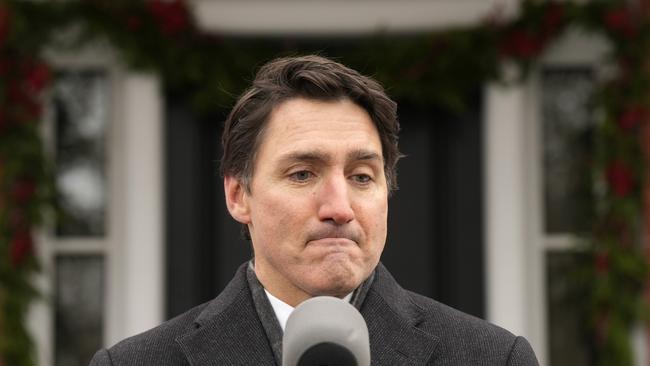
The same could be said for the fate of a head of government under pressure to stay in power after almost a decade in office. Canada’s Prime Minister, Justin Trudeau, was caught in this trap, as Canadians face the combined burden of cost-of-living pressures, unaffordable housing and now rising unemployment.
Add in extraordinarily high rates of immigration and the scene was set for a dramatic loss in electoral support for the Trudeau government, something that was evident well before the election of Donald Trump in the US in November.
Note here that the Canadian rates of net overseas migration have been exceeded over the past decade only by Qatar and Bahrain. Even Australia’s high NOM has been lower than Canada’s.
In 2023, Canada’s population grew by 3.2 per cent, or close to 1.3 million. Ninety per cent of the increase was due to immigration. High migrant intakes have become increasingly unpopular among Canadian voters.
Ultimately, the economic stresses many Canadians have had to endure have outweighed Trudeau’s cheerful manner and his headlong pursuit of progressive causes, including his enthusiastic promotion of climate action for his country, including implementing a rising carbon tax.
His heavy-handed behaviour during the Covid pandemic also ultimately contributed to his loss of public appeal. Trudeau’s intolerance for different points of view as well as his response to the legitimate objections to mandatory vaccination provided a valuable opening for Pierre Poilievre, leader of the Conservative Party, to enhance his visibility with the electorate.
While most countries ramped up government spending in response to the pandemic, Canada was a standout, with a budget deficit of almost 15 per cent being recorded in 2020-21.
In fact, every budget handed down during Trudeau’s term in office has required red ink. In last year’s budget, it was forecast that the Canadian federal budget would remain in deficit for the rest of this decade. (If this sounds familiar, you are not wrong – it’s the same here.)
Unsurprisingly, given the surge of government spending, inflation became a problem in Canada from 2022, with the maximum rate reaching close to 9 per cent, the highest figure recorded for 40 years.
This required the Bank of Canada, the country’s central bank, to raise the official interest rate, which then fed into higher mortgage rates. The top rate of 5 per cent was reached in July 2023. The current official interest rate is now 3.5 per cent.
The core of Canada’s economic problems is the slump in productivity. Between 2021 and 2024, productivity had fallen in each year. The main source of the fall in productivity has been in the goods sector, with lower investment per worker evident.
At the turn of the century, average labour productivity in Canada relative to the US stood at 82 per cent; it has since slipped to around 77 per cent.
The combination of high population growth and sluggish GDP growth means that per capita real GDP is now 7 per cent below its long-term trend, or more than $C4000 ($4458) per person. It’s no wonder Canadian voters are grumpy.
A standout feature of the Canadian economy is its integration and dependence on the US economy. Around three-quarters of exports from Canada head south and there is a degree of integration of some industries between the two countries – for example, in the automotive industry, with parts and assembly. Both the North American Free Trade Agreement that came into effect in 1994 and its subsequent version, the United States-Mexico-Canada Agreement that came into effect in 2020, have been important sources of economic gain for Canada.
It’s why the threat of tariffs being imposed by the US is potentially a major threat to the Canadian economy.
A material figure of 25 per cent has been mentioned. While it is very unclear whether Trump will follow through with this threat, it is something that the Canadian government has to be prepared for.
It had been apparent for some time that Trudeau was not the leader to deal with the threat; it was one of the reasons for the breakdown in the relationship between him and the former deputy prime minister and finance minister (our treasurer), Chrystia Freeland.
Trudeau was more concerned with propping up his short-term popularity, hence the month-long pause in the federal GST on some goods, including beer, as well as the proposal to hand out $C250 to every Canadian adult. Freeland, on the other hand, was keen to prepare for a possible trade war with the US and to retain some fiscal buffer.
Freeland’s demotion and subsequent resignation was the last straw, ushering in Trudeau’s forced departure.
Canada is an example of voters who will tolerate the pursuit of woke obsessions – Trudeau was fixated with indigenous and refugee rights, as well as the pursuit of diversity, equity and inclusion, and climate action – only if living standards are rising and citizens can get ahead by working hard.
While moderate migrant intakes are tolerated, even welcomed, excessive net overseas migration is a highway to political unpopularity. Trudeau learnt this lesson far too late.
For a man with a very thin CV to start with, a term of more than nine years is quite an achievement. His good looks and affable manner – he is something of a hero outside Canada, like New Zealand’s Jacinda Ardern – got him a long way. But ultimately, Trudeau’s lack of appreciation of sound economic and fiscal management contributed to his downfall.






“It’s the economy, stupid” is the core explanation of election outcomes according to James Carville, adviser to US president Bill Clinton.